News & Views
Don’t Take It Easy
Richard Gault is inspired by Michael Easter’s book The Comfort Crisis and explores the idea of ‘misogi’ during a 600-mile walk across Scotland
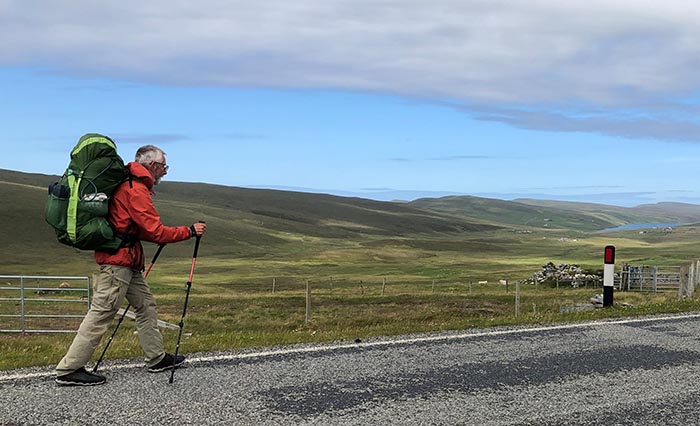
Richard on his long walk across Scotland, from the southernmost tip at Mull of Galloway to Hermaness Head in the Shetland Isles. Photograph: Richard Gault
Are you sitting comfortably? The chances are that you are. Then I will begin by suggesting that maybe you should not be. This, at any rate, is one of the core messages contained in Michael Easter’s iconoclastic book, The Comfort Crisis.[1] His argument is that modern, western civilisation has directed technology towards offering us ever more ease. A telling example is the widespread escalator that carries us upward without effort. Given the choice, only two per cent of us will take the stairs. Ease means we drive rather than walk, enjoy homes heated at a one-time programmed switch, eat food delivered to us to be quickly heated in a microwave. Ease means that we never need be bored when our smartphone or laptop is a simple swipe away.
But the ironic tragedy, Easter shows, is that ease also involves ignoring our inevitable mortality. Striving for it explains the rise of the diseases that characterise our society. Science and technology have freed us from illnesses once prevalent, such as typhoid and cholera, and infant mortality is rare. But now we have cancers, strokes, diabetes and alarming rates of mental health problems.
What can be done about this? Easter asks. His answer is that we need to acknowledge that as humans we have evolved to deal with discomfort. We are only a few generations away from our ancestors who regularly knew cold and hunger, and were familiar with effort. In fact, our bodies (and minds) are designed or adapted to not just tolerate discomfort but to gain from it. So, he concludes, the way to health – physical, mental and spiritual – is to accept and indeed to seek out ‘discomfort’.
Easter introduces us to a special form of ‘discomfort’, misogi [/]. Derived from Japanese, Easter’s misogi means putting oneself to a physically and mentally challenging test of endurance. The original Japanese word referred to an act of spiritual purification. Easter’s meaning is closer to that of a ‘rite of passage’. His most radical advice is to get up and challenge ourselves to our own misogi and discover how we emerge better from it. For example, we could resolve to get up an hour earlier every day for the next month and walk, whatever the weather and however late we got to sleep, three miles before breakfast. Or to swim in the sea through the winter. The misogi is personal: what might be feasible for a friend – running a half marathon, perhaps – could be our mountain. It has to be a challenge with a real chance that we will not succeed in meeting it.
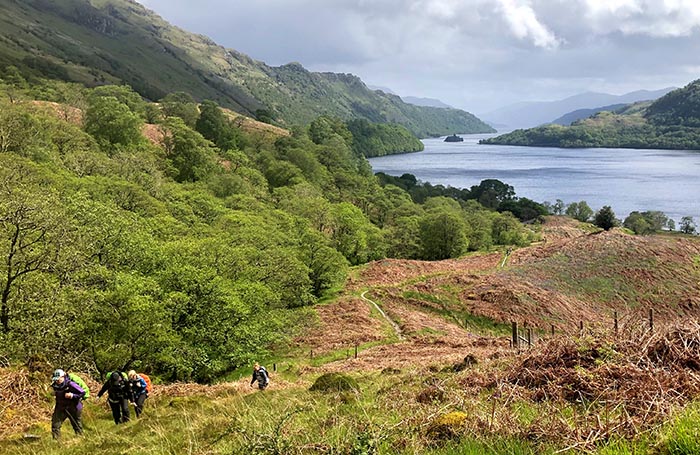
Northern Loch Lomond seen from the West Highland Way. Photograph: Richard Gault
Misogi in Action in Scotland
.
Easter’s own misogi was a month-long hunting expedition in the northernmost reach of Alaska, where he found plenty of cold, hunger and exhaustion. In his book, he weaves the account of the trials he faced with research which provides the scientific evidence that comfort, if it is not killing us, is doing us no favours in the long run. I embarked on my own misogi a couple of years ago when I walked the length of Scotland, starting at the southernmost tip of the Mull of Galloway and finishing at its northernmost point. A lot of people I spoke to assumed that this meant that I would be ending my journey at John O’Groats, but Hermaness Head on the Shetland island of Unst is actually where Scotland runs out and that is 170 miles north of John O’Groats.
Scotland is not the Alaskan wilderness. I did not plan to always sleep in the tent I carried. B&Bs, hostels or hotels regularly offered me a proper bed and a shower, and I was never more than two days away from a shop, so I was not weighed down carrying months-worth of supplies. Nevertheless, carrying more than 15 kilos on my back for 600 miles was a challenge for me and my septuagenarian body, and one I could not assume that I would meet when I began.
While family members and friends planned to join me for a few weeks of the eleven-week journey, I was alone most of the time. Before I left, I bumped into an acquaintance who is very much a loner, a man who often goes off by himself for months on end. When I told him of my plan and my slight anxiety about being so long on my own, he said: ‘Richard, you will be alone, but you won’t be lonely.’ Cultivating the ability to be alone is one of the lessons Easter says many of us need to learn: ‘Research backs solitude’s healthy properties. It’s been shown to improve productivity, creativity, empathy, and happiness, and decrease self-consciousness.’ (p. 79)
But was my walk a true misogi? Easter quotes the man who introduced him to the concept:
In a perfectly designed misogi, you give it everything you have and you just finish it. Or maybe you just barely fail… To finish it with a lot left is not really doing it right. (p. 54)
Well, spoiler alert, I did fail. I was struck by Covid just after reaching Shetland, so for five days I had to isolate and could not walk. Out of quarantine, I took a bus and caught up with my planned itinerary and schedule. Furthermore, I completed the final week as I had all other weeks – without difficulty. When I stood atop the cliffs of Hermanness Head with puffins wheeling below me, I had walked all but 45 of the 600 miles separating me from the Mull of Galloway. But I had got as far north as possible without experiencing any real hardship, not even suffering a blister along the way.
Not a ‘perfectly designed’ misogi then. Nevertheless, it seemed like an accomplishment. Many people I met on the way were surprised to learn what I was doing and reacted with: ‘Oh, I could never do that!’ Part of the reason I have published a book about my walk [2] is that I hope it might encourage others to revise their idea of their limits – an aim I share with Michael Easter.
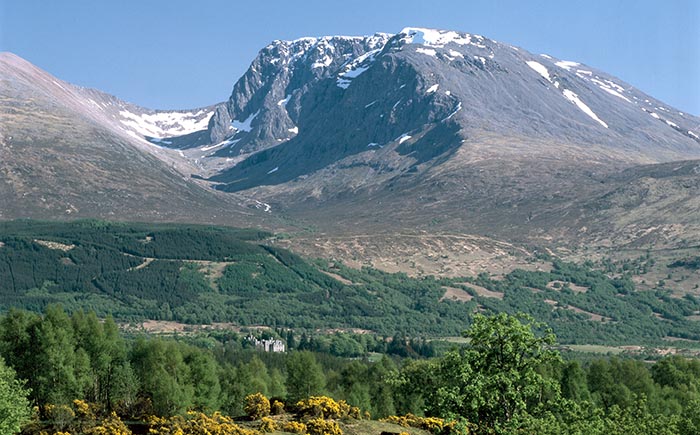
Ben Nevis, the highest peak in Britain, from Fort William at the end of the West Highland Way. Photograph: John MacPherson [/] / Alamy Stock Photo
Nature and Silence
.
The challenges my walk presented were definitely not as severe as Easter’s, but they were real. I was not always ‘comfortable’. Gale-force winds all too often battered me; rain soaked me. The summits of mountain passes sometimes never seemed to get closer. I had to negotiate rocky routes where a slip would have ended my endeavour, and to overcome my fear of heights to tread the narrow, treacherous cliff top paths of Caithness (being rewarded with the most spectacular coastal scenery imaginable, which would have been invisible from the nearby road). There are no bears in Scotland but I was attacked by midges, tics, cows and arctic terns. These terns may see more sunshine than any other creature on this planet but this has not given them a sunny disposition!
Like Easter, I spent many weeks simply being in nature. I revelled in the majesty of mountains, the rumble and rush of foaming burns, the sound of surf serenading me as I tramped long pristine beaches. I heard the strange call of eider ducks; was eyed by inquisitive seals; witnessed cliff ledges crowded with nesting guillemots. I was enraptured by carpets of bluebells, learned the origin of the names of a great many flowers, such as the gentian blue milkwort, and discovered a plant that oddly is greener in winter than in summer (the polypody fern).
I was always happy to be far from roads and the sound of traffic. Easter explains how important silence is for us (pp. 126 –31). This is just one reason he regards it as good to spend time in nature.
There could be a lot of reasons why nature – wilder spaces in particular – [benefit] the mind and body. It could be that in nature you are engulfed in fractals, complex patterns that repeat over and over in different sizes and scales and make up the design of the universe. Think trees (big branch to smaller branch to smaller branch and so on), river systems (little river to bigger river to bigger river and so on), mountain ranges, clouds, seashells. Cities don’t have fractals. (p. 120)
(Oddly enough, I have written an article on fractals for Beshara Magazine: click here)
Easter also extols the virtues of ‘rucking’, walking while carrying a weight on your back, and I did plenty of that. Humans, he suggests, are born to carry rather than run (p. 233). Rucking as a form of exercise is therefore more beneficial than running, offering ‘strength and cardio in one’ (p. 237). And safer; he points out that up to half or more of runners will suffer an injury in any year (p. 248). So through my walk, I experienced much that Easter shows is good for us – being alone, in silence, in nature. Hence, I knew the benefits of a long-distance misogi even if I had not truly done one because I did ‘finish with a lot left’.
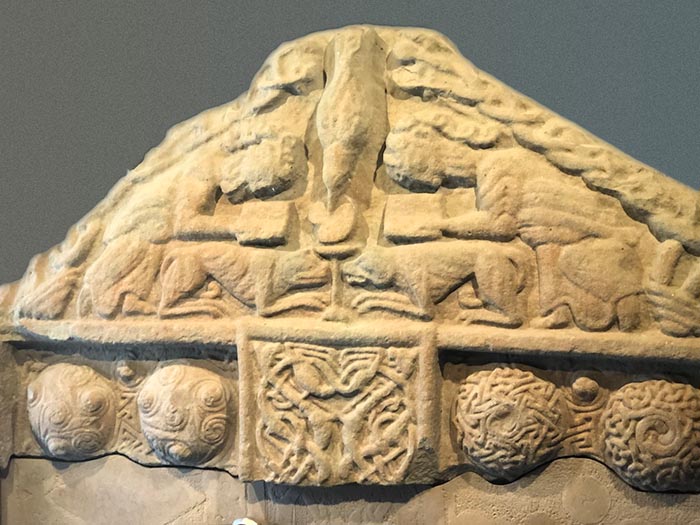
The Nigg Stone, a Pictish monument dating from the eighth century which is thought to be the earliest depiction of the eucharist in the UK. It is now housed in Nigg Church in the village of Nigg on the Cromarty Firth. Photograph: Richard Gault
Taking Time
.
But there were other aspects to my journey. I took my time, rarely covering more than 12 miles in a day and giving myself a day off every week. This was because I did not see my walk as simply one that took me though space. I walked exploring time, too, and time travel takes time.
Not everyone takes this approach. My route took me along the West Highland Way, which is by far the most popular long-distance trail in Scotland. It is 96 fabulous miles from Glasgow to Fort William, plus a total climb of over 3000 metres. I met many walkers on it aiming to complete the trail in five days. That may be a misogi, but it’s also a tragedy. Like the man I met near the end of his 80-day, non-stop walk from Land’s End to John O’Groats, these hikers do not have time to really appreciate the magnificence of the landscape they are rushing through. Nor do they have the opportunity to explore the stories hidden in the land. The desire for speed is a feature of the modern world, as I have explained in my recent TEDx talk [/], so I was not taken by surprise by these hasty walkers.
By the end of the 11 weeks, I felt that I had a much richer, deeper and more profound connection to Scotland’s past, a history spanning six millennia. I had visited the oldest building in Northern Europe, the Knap of Howar on Orkney, built more than 5000 years ago by neolithic farmers, thousands of years before the Picts inhabited much of Scotland. I had gazed in wonder at one of the Pict’s exquisitely carved monuments, ‘The Nigg Stone’ [/], dating from the end of the eighth century and featuring the earliest known depiction of the Eucharist in Europe.
The Picts were converted by Christian missionaries, amongst them St Ninian, whose shrine is close to where I began walking. I encountered many other Christian, often Irish, saints along the way. Learning their stories, I wondered not so much how they arose but how they have continued to have such a place in people’s faith for centuries. Robert the Bruce, for instance, insisted on going into battle accompanied by the relic of the long-dead saint St Fillan. He credited his victory at Bannockburn to the presence of the bone of Fillan’s left arm, ‘the Mayne’. The story is that as a young novice monk, Fillan had prayed for light to allow him to keep studying at night. His prayer was answered: his left arm could glow brightly enough for him to read by. Without Fillan’s bone, or at least Bruce’s faith in it, Scotland might have disappeared as a nation. I learned of St Fillan while strolling through the strath named after him – it is part of the West Highland Way, easily missed by five-day day walkers.
Bannockburn was, of course, just one of many battles to have been fought in Scotland. The country’s history can be told as one of wars: those fought by the Irish Gaels against the Picts; the battles against the English and the Vikings; the inter-clan strife at Glencoe, and the series of Jacobite uprisings culminating at Culloden. In the twentieth century Scotland was never on the front line of its wars and yet without the Scottish contribution, things might have not ended as they did. Approaching Stranraer, I learned that this is where the Dambusters practised for their mission and, more significantly, how preparations for the D-Day landings were assembled close to the town. Further on, I came to remote Achnacarry where commandos were trained. I left these places with a greater, if not awakened, sense of how much I owe to the efforts and sacrifices of those who lived before me.
The effects of wars do not end when the battles are over. The route of the West Highland Way includes old military roads built by the British Government across the Highlands in response to the Jacobite uprisings. They wanted to ensure that the army could easily be deployed to the remotest parts should Highlanders ever rebel. More radical was the ethnocide, the deliberate policy of destroying the Gaelic culture which included banning the kilt but went much further.
Hundreds of thousands of people were forced from their homes during the Highland Clearances in the 18th and 19th centuries. Many died. Many emigrated to America, Canada, Australia and New Zealand; I met some of their descendants coming to Scotland seeking their roots. Some stayed to eke out an existence in the most inhospitable of places. My walk took me through one such clearance village, Badbea: ‘bad’ by name and ‘bad’ by nature. Here, families lived so close to a cliff that livestock and children were tethered to stop them from being blown into the sea. It was painful to imagine how they had suffered or to contemplate the cruelty of the wealthy landlord who had inflicted this upon them.
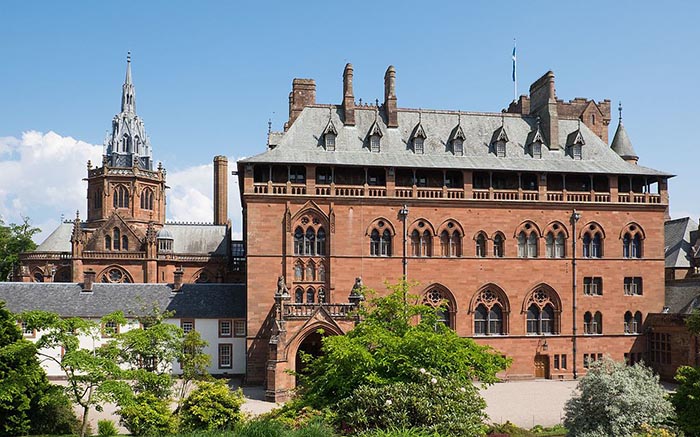
Mount Stuart, home of the 19th-century philanthropist the Marquis of Bute, in South-west Scotland. Photograph: wikimedia
Encounters
.
One can despair at the inhumanity of man to man, but as well as the saints and the brave soldiers of the twentieth century, I encountered many heartening and inspiring people of the past and the present. The ferry I took from the Black Isle is known as the King’s Ferry because James IV of Scotland travelled this way on his annual pilgrimage to the shrine of St Duthac, a little further north in Tain. James IV was a beneficent and wise king if ever there was one. A distant descendant of his was the Third Marquis of Bute [/]. I left my tour of the house he built, Mount Stuart on Bute, in awe of the man. He had the wealth of today’s billionaires but used it to advance beauty and knowledge, creating an extraordinary heritage of magnificent buildings and medical facilities in St Andrews and Cardiff. I also walked roads built by Thomas Telford, the first civil engineer who was dubbed ‘The Colossus of Roads’ because of his engineering of highways in both England and Scotland. Here was another man who applied his skills for the benefit of the communities he served.
I met many remarkable living people as well. There was Sheila near Irvine who had successfully campaigned for all the 2000 women executed under the 1563 Witchcraft Act to be formally pardoned. And the Scottish Woman of the Year 1975, Mhairi Campbell, in Dornoch. She had been chosen for her work with Mother Theresa, but this was just one episode in the fascinating life story she related to me. I also shared an island-hopping plane ride in Orkney with Saoirse Ronan who had been working there as the star of the film The Outrun [/]. Then on the remote Shetland island of Yell, I met Bettina Wilcher who was writing up her research on the treatment of dementia. We went on to interview her for Beshara Magazine (click here).
Everywhere I was the recipient of wonderful hospitality, none more so than on Unst, where I met Nigel, a crofter. After a ten-minute conversation he offered to give me some of his own Shetland lamb, which is not available in any butcher’s shop. I accepted, but had not expected to be given so much – over two kilograms of prime meat. He refused to let me go without me taking all of it. Fortunately, this was at the very end of my walk. The next day, I returned laden to Inverness to stay with my son, and there we feasted on the best Shetland could offer.
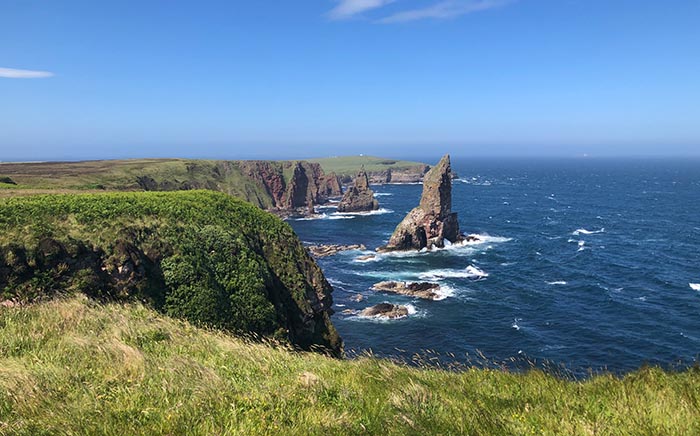
View towards Dunscansby Head, near John O’Groats. Photograph: Richard Gault
More to Life than Being Fit
.
Overall, I felt that my walk benefited me in more ways than a bare misogi could. Yes, I was fitter and knew myself in new ways, ways that deserved respect and gratitude. I had forged closer bonds with nature, as Easter had done in Alaska. But I had also been able to draw the past to me and discover the bountiful wisdom it contains. It is a past that reaches out far beyond Scotland’s borders, just as the present extended beyond me through the people I met. I had been constantly moving but found a greater sense of myself as the still centre of an ever-widening web.
Easter’s argument in The Comfort Crisis is that we need to be physically fit. ‘Fitness fends off most maladies,’ he writes. ‘Research… suggests that the more a person marinates in exercise-induced discomfort, the more death resistant they’ll be.’ (pp. 244–245). He is right to say that we can live healthier lives, but we should not forget why we might want to. Health cannot be an end in itself. As I discovered, there is much to be learned about yourself and the world when you get up and out of your comfortable chair.
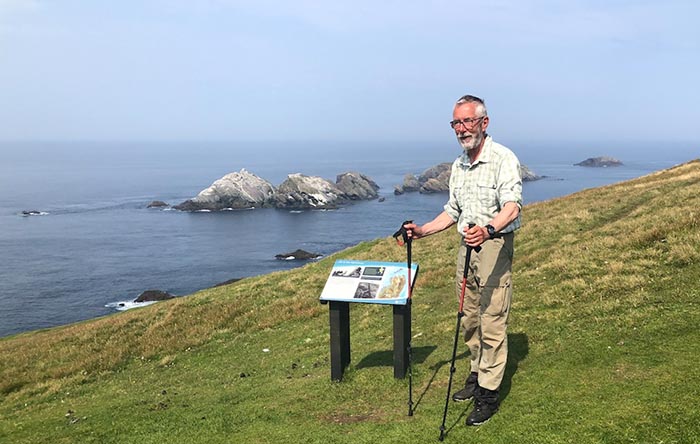
Richard at the end of his walk, at Hermaness Head on the Shetland Island of`Unst. Photograph: Richard Gault
Sources (click to open)
[1] MICHAEL EASTER, The Comfort Crisis: Embrace Discomfort To Reclaim Your Wild, Happy, Healthy Self (Rodale Books, 2021).
[2] RICHARD GAULT, Half Longing Scotland: Wondering to Inverness (Austin Macauley, 2024).
Dr Richard Gault has worked at universities in Scotland, Ireland, the Netherlands and Germany where he has taught and researched a variety of subjects including the history and philosophy of science and technology. He is a long-term student of the Beshara School and from 2015–17 was Principal of the Chisholme Institute in Scotland. His book Half Longing Scotland (2024) describes the first half of his 2022 walk. He is currently completing his account of the second half of his journey to be called Completely Longing Scotland.
The text of this article has a Creative Commons Licence BY-NC-ND 4.0 [/]. We are not able to give permission for reproduction of the illustrations; details of their sources are given in the captions.
read more in beshara magazine
More News & Views
Book Review: ‘The Serviceberry’
Martha Cass contemplates the message of a new book by Robin Wall Kimmerer that advocates ‘an economy of gifts and abundance’
Book Review: ‘Conversations with Dostoevsky’
Andrew Watson engages with an innovative new book by George Pattison which explores Dostoevsky’s relevance in the contemporary world
Thich Nhat Hanh & the Poetry of Engaged Buddhism
Philip Brown presents the poem ‘Recommendation’ and comments on the potential of contemplative art to foster compassion
Introducing… ‘Perfect Days’ and ‘Nowhere Special’
Jane Clark watches two films with a contemplative theme
Book Review: ‘Irreducible: Consciousness, Life, Computers and Human Nature’
Richard Gault reviews a new book by Federico Faggin, one of the leading lights of the science of consciousness
An Irish Atlantic Rainforest
Peter Mabey reviews a new book by Eoghan Daltun which presents an inspiring example of individual action in the face of climate change
FOLLOW AND LIKE US
——————————————
——————————————
——————————————
If you enjoyed reading this article
Please leave a comment below.
Please also consider making a donation to support the work of Beshara Magazine. The magazine relies entirely on voluntary support. Donations received through this website go towards editorial expenses, eg. image rights, travel expenses, and website maintenance and development costs.
READERS’ COMMENTS
1 Comment
Submit a Comment
FOLLOW AND LIKE US

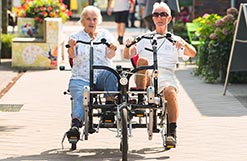
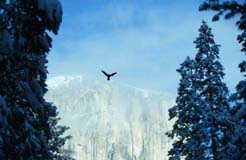
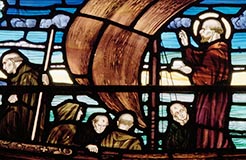
A lovely article. It made me realise how the most satisfying experiences in my life have been those that stretched me to a limit. I have just spent my first night in a little house that I decided to build for myself nearly a year ago. It’s always been a dream of mine, but when I started, I really wasn’t very confident I could finish it. It isn’t quite finished yet, but it’s very satisfying to be able to sleep in it, albeit in some discomfort!